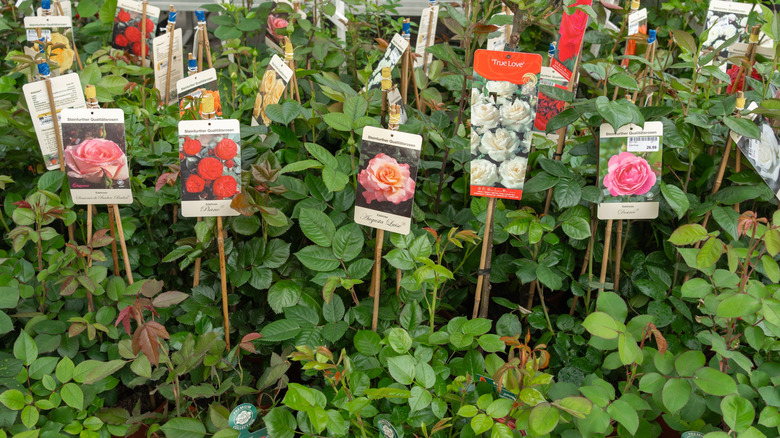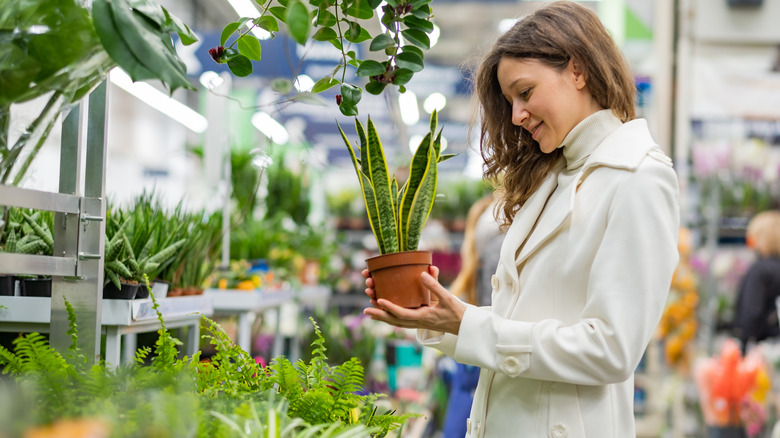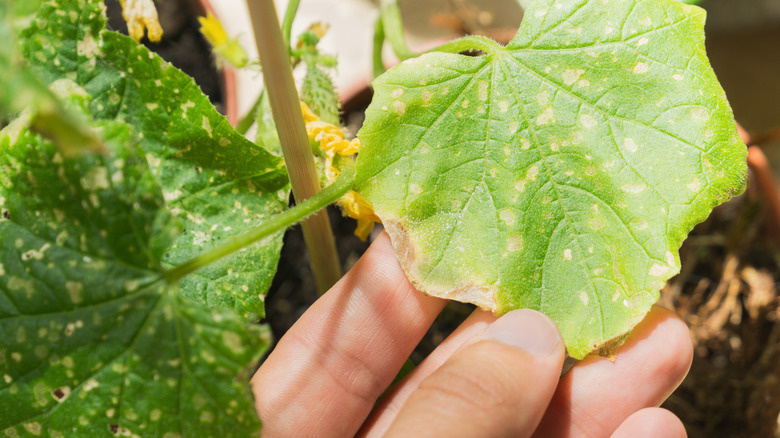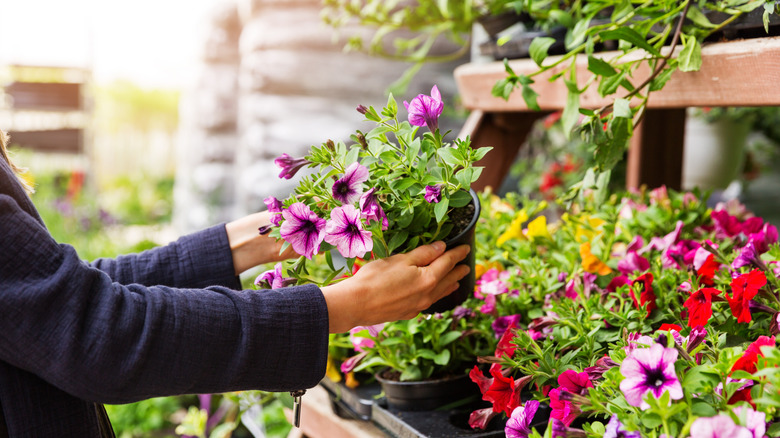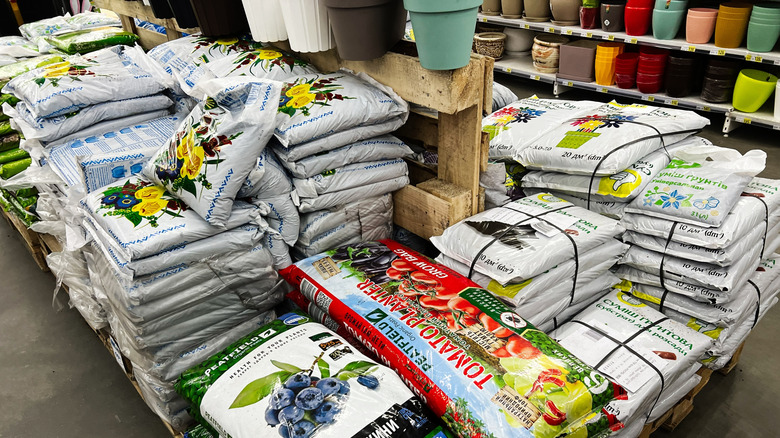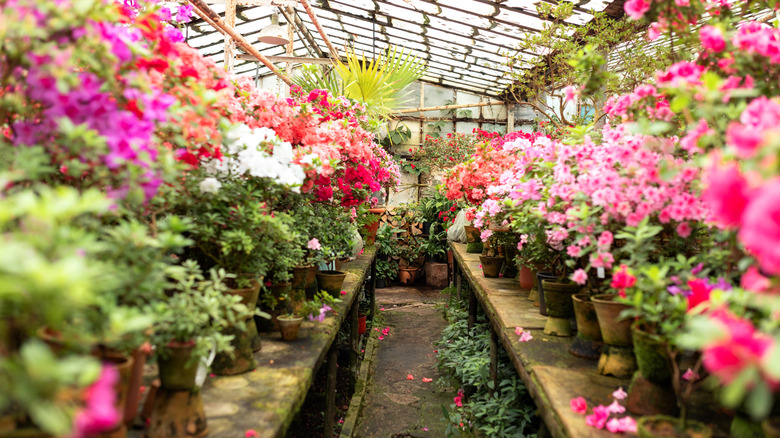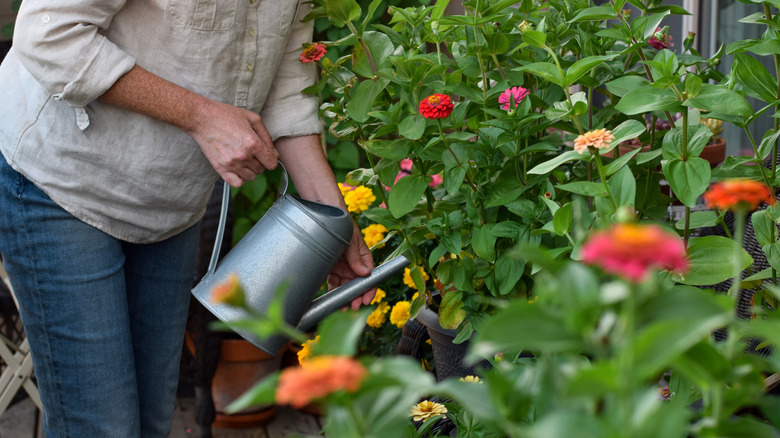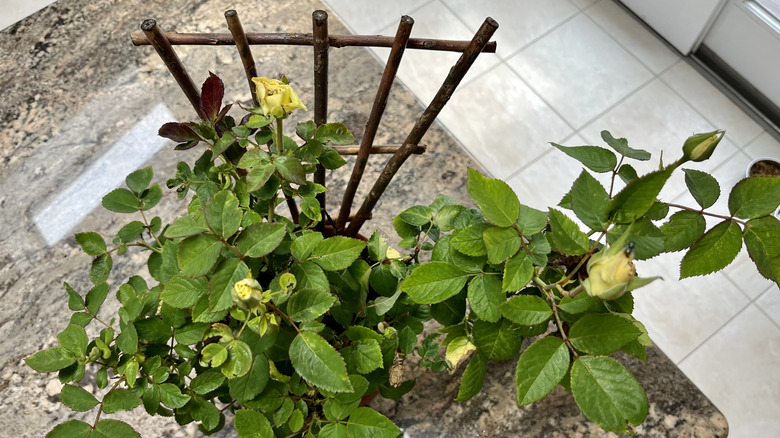13 Common Mistakes To Avoid When Buying Potted Plants For Your Garden
We may receive a commission on purchases made from links.
Shopping for new potted plants is one of the most exciting steps for building a container garden. Sadly, though, it's also the point where simple mistakes can snowball into long-term headaches if you're not careful. Whether you're shopping at a local nursery, big box store, or street fair booth, knowing what pitfalls to keep an eye out for can save you so much money and heartbreak. Unfortunately, many potted plants may look lush and healthy at the store but can be hiding pests, diseases, or just end up being a bad fit for your situation.
So, before you break out the credit card, let's cover the 13 main things we think you should look out for when buying a new potted plant. We'll go over the potential problems it can lead to and what to do instead so that you can be as confident as possible that you've picked the best new leafy friend for your home.
Ignoring plant labels and growing conditions
It's easy to get caught up in the beauty and shiny object factor of a new plant before you bring it home, but ignoring those big, informative tags can end up causing more problems than you think. Many popular plants, from orchids to succulents and everything in between, have very specific requirements for water, light, soil, fertilizer, and humidity. Ignoring those or thinking you can wing it means you might end up with a sad-looking plant that never flourishes.
Luckily, this is easy to fix. Most plant labels now are fairly standardized so you can get a quick summary of what your potential new plant needs to thrive. Look at the light and water requirements, as those are usually pretty hard to improvise on, then make sure you have the right kind of soil and fertilizer this plant needs. Some plants, like gardenias, want more acidic pH levels than your standard tropical houseplant like a monstera. Making sure you can meet the requirements on the label is a small but important step that sets you on the path to plant success.
Making impulse buys without a plan
Look, we've all been there, but impulse buying plants without a plan is a mistake that will lead to nothing but frustration and a blown plant budget. You might pick a plant that looks pretty or is on one of the latest trendiest houseplants list, but it's easy to forget that successful container gardening depends on whether or not the plant suits your space and routine. Carnivorous plants, for example, can't handle tap water so need distilled or rainwater. Do you have the ability to collect rain or store a gallon of distilled water? If not, that pretty Venus flytrap is going to end up black and sad.
Instead, take time before your shopping trip to research what kind of plants will thrive in your garden and can survive your lifestyle. If you're someone who likes to travel, for example, then skip the high-maintenance exotics and stick to potted plants that can thrive on neglect, like sage, hostas, or sedum for your patio or snake plants indoors. They may not be as exotic as those rarer or lab-created cultivars, but they'll also outlast any diva plant that can't hack it in your space.
Overlooking signs of unhealthy plants
Buying a plant that looks sad, wilted, or has yellowing, mottled, or spotted leaves is a rookie mistake. Unfortunately, these symptoms probably indicate that the plant has been stressed by poor watering, pests, or disease, and it may never fully recover once home. Limp stems, broken branches, or damaged trunks also signal trouble ahead. Taking home an unhealthy plant sets you up for frustration and extra time nursing it back, if it even makes it.
To avoid this headache, choose plants that look vibrant and healthy with firm, upright growth and bright, even foliage. Check the soil moisture to ensure it's neither soggy nor bone dry. Look for signs of new growth, like sprouts and offshoots, as this means the plant has enough resources to propagate itself, and avoid plants with pests or root issues. When possible, try to inspect roots through drainage holes or gently remove the plant from its pot. A little vigilance now means healthier plants and less worry later in your garden.
Not checking for drainage holes
Buying plants in containers without drainage holes is a huge mistake that will almost guarantee root rot down the line. Water needs a way to escape or it pools at the bottom, suffocating the roots with soggy, moldy soil. While most garden center plants come with proper drainage, you might run into issues at flea markets or gift shops where someone arranged a cute succulent display in a decorative pot without thinking about water flow. Once you get it home, your plant is doomed unless you fix the problem.
The solution is simple: make it a habit to always first check for drainage holes before bringing a plant home. If your container doesn't have them, you'll need to add drainage holes to the plant pots by either using a masonry or glass bit (for ceramic pots), or repot the plant into something more appropriate. It's a small step that prevents waterlogged roots and keeps your plants thriving.
Assuming the plant can live in the container you bought it in
Assuming the plant can live long-term in the container you bought it in is a common mistake that can stunt growth or even kill your plant. Most garden centers place plants on the shop floor that have just about maxed out their pot space, meaning they're already root-bound or close to it. Small containers also dry out way too fast outdoors, especially in sunny or windy spots, leaving your plants stressed and thirsty. Basically, what looks fine on a shelf won't necessarily work once you get it home.
To check if your plant needs repotting, look for roots poking out of drainage holes or circling the top of the soil. Gently remove the plant from its container, and examine the root ball. If roots are tightly wrapped around the outside or form a dense mat with little soil visible, the plant is root-bound and needs a bigger home. Luckily, repotting plants is easy, and plopping them into a larger container gives roots room to grow, improves moisture retention, and keeps your plants thriving instead of struggling.
Not shopping for the appropriate potting mix when picking up plants
Not buying the right potting mix when picking up plants is a mistake that can leave you scrambling when it's time to repot. Since many plants will eventually need fresh soil or a larger container, grabbing whatever random bag of dirt is on sale won't cut it. Quality potting soil is lightweight and typically contains ingredients that provide proper nutrients, airflow, and drainage that containerized plants desperately need to thrive.
To avoid this issue, swing by the soil aisle while you're at the garden center and pick up a bag of potting mix labeled for your plant type or you can DIY a soil mix without too much effort. This ensures you have the right medium ready when the time comes, rather than trying to fix things later or settling for subpar soil. Using the right potting mix gives your plants the best foundation for healthy growth and saves you from dealing with drainage problems or nutrient deficiencies down the road.
Not checking for pests
Common plant pests like spider mites, mealybugs, or aphids love to hide on the undersides of leaves or in stem crevices, and you might not spot them right away, making this a big mistake that turns into a huge problem almost instantly. Once you bring that infested plant home, it can spread to your entire collection, turning a single purchase into a nightmare of treatments and quarantine. Big box stores in particular are notorious for plants with pest problems, so you've got to be extra vigilant.
While you don't need to bring a magnifying glass with you, you should always take time to inspect plants thoroughly before buying. Check under the leaves, around stems, and along the soil surface for sticky residue, webbing, tiny moving specks, or white cottony spots. You can use your phone's camera zoom to really get in there and make sure things are okay. If you see any warning signs, put that plant back and find a healthier one.
Not quarantining your new plants
Not quarantining your new plants is a mistake that can devastate your entire collection. To pull back the curtain a little, I have over 250 plants in my collection, so yeah, I've dealt with a few pest infestations over the years. Consequently, I feel like I can't stress this enough: even a plant that looks perfectly healthy can harbor hidden pests or fungal infections. The main reason to quarantine is pest control, because the last thing anyone wants is a whole collection of plants infested by one guilty culprit. Spider mites, mealybugs, thrips, and fungus gnats are sneaky, and their eggs are often invisible to the naked eye until it's too late.
To avoid disaster, always isolate new plants in a separate room, quarantine box, or at least 3 to 6 feet away from your existing collection for two to four weeks. Check in regularly and look for warning signs like webbing, sticky residue, tiny moving specks, or discolored leaves. If you catch issues early during quarantine, you can treat that one plant instead of battling an infestation across your entire garden. It's a simple step that protects all your hard work and keeps your plants thriving.
Buying plants that are already in full bloom
Buying plants that are already in full bloom might seem like a great choice, but it's actually a mistake that can leave your garden looking bare throughout most of the growing season. While those gorgeous flowers are tempting, focusing only on blooming plants means you end up creating a garden with heavy temporary color but little interest later. Plus, flowers aren't actually a sign of good health or high quality, they're just part of the plant's natural cycle. A plant can be stressed and still produce blooms as a survival mechanism.
Instead of getting distracted by flowers, look for plants with healthy foliage, strong stems, and vigorous new growth. These indicators tell you the plant has energy to spare and will perform well long-term. If you want continuous blooms throughout the season, choose plants at different stages so some are budding while others are just starting to grow. This approach gives you a garden that looks vibrant from spring through fall instead of peaking once and fading.
Buying incompatible plants for the same pot
It's tempting to grab a bunch of plants that look pretty together in your shopping cart, but this doesn't mean they'll actually thrive in the same container. Every plant in a shared pot receives the same sunlight, water, and soil conditions, so mismatched plants can create problems. For example, pairing a sun-loving succulent with a shade-preferring fern guarantees one will suffer no matter what you do. One plant ends up drowning while the other withers, leaving you frustrated and out of money.
The best way to prevent this is to check the labels to make sure all your selections want the same light exposure, whether that's full sun, partial shade, or deep shade. Match watering needs too, since you can't water one plant without watering the rest. Also consider growth rates, as some plants grow aggressively while others stay compact.
Treating potted plants the same as in-ground plants when watering
Container plants tend to dry out much faster than in-ground plants, so treating them the same when watering is a mistake that leads to stressed, wilted plants. Water escapes quickly through drainage holes, evaporates from the sides of porous containers like terracotta, and disappears from the soil surface exposed to sun and wind. This means potted plants often need daily watering during hot weather, while garden beds might be fine for days and ignoring this difference leaves your containers bone dry while your garden beds stay moist.
To fix this, check container soil moisture daily by sticking your finger an inch or two into the soil. If your finger comes back clean, it's time to give your plant a drink. The early morning is the best time to day to water them since it helps prevent soggy soil. Water deeply until it flows from the drainage holes, ensuring the entire rootball gets hydrated. You can also line porous pots or use mulch on the soil surface to slow evaporation and reduce how often you need to water, just make sure the drainage holes stay clear.
Not planning for support needs when buying sprawling species or potted climbers
Buying climbers, vining plants, or sprawling vegetables without planning for their support needs is a mistake that leaves your plants sad and wilty. Plants like jasmine, clematis, mandevilla, tomatoes, cucumbers, and beans all need something sturdy to climb or grow onto, and a single bamboo stick won't cut it. Without proper support, flowering climbers reach around desperately trying to find something for their tendrils to grab, while heavy fruiting plants can collapse, leading to cracked stems, spoiled produce touching the ground, or pest problems.
So, to prevent ending up with unhappy plants that never reach their potential, make sure you have a proper trellis, cage, or staking system ready to go for the plants that need it. For climbers, install a sturdy trellis or wire mesh they can actually attach to. For vegetables, use tomato cages or external staking systems that won't tip over in wind. We like the Stackable Plant Trellis Pack of 6 from Feitore because it can grow with your plants, but the important part is to plan support structures before bringing plants home so you can install them right away, giving your plants the vertical growing space they need to thrive.
Assuming you never have to prune newly-purchased potted plants
It's easy to think that once you bring a plant home, the growing can continue on as-is. But many store-bought plants arrive leggy, overgrown, or with diseased growth that drains resources. It might feel counterintuitive to cut back a plant you just bought, but for species like petunias, herbs, or veggies, a quick trim triggers bushier, stronger growth and better airflow.
To set your plants up for success, inspect them once you get home and pinch back leggy stems, remove yellowing or diseased foliage, or trim weak branches. This redirects energy to healthy new growth and improves air circulation, reducing disease risk. For flowering plants, removing spent blooms or cutting straggly stems promotes fuller blooms later.

